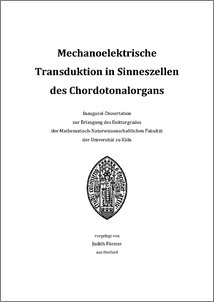Förster, Judith
(2014).
Mechanoelektrische Transduktion in Sinneszellen des Chordotonalorgans.
PhD thesis, Universität zu Köln.

![[img]](https://kups.ub.uni-koeln.de/style/images/fileicons/application_pdf.png)  Preview |
|
PDF
J._Foerster_-_Diss_2014.pdf
- Published Version
Download (3MB)
|
Abstract
Pymetrozin ist ein Insektizid, welches gegen Blattläuse eingesetzt wird. Es induziert bei Insekten eine Streckung der Beine und des Rüssels, tötet sie aber nicht direkt, da es über die Zeit seine Wirkung verliert. Jedoch überleben Blattläuse eine Applikation nicht, da sie bewegungsunfähig verhungern. Experimente mit Europäischen Wanderheuschrecken haben gezeigt, dass Pymetrozin auf die Gesamtaktivität von sensorischen Neuronen des femoralen Chordotonalorgans (fCO) wirkt (Ausborn et al. 2005; Kaufmann et al. 2004). Der zu Grunde liegende Wirkmechanismus von Pymetrozin ist bisher allerding unbekannt.
Anhand der Ergebnisse lassen sich zwei mögliche Wirkmechanismen von Pymetrozin vermuten: (1) Pymetrozin beeinflusst den mechanoelektrischen Transduktionsprozess oder (2) beeinflusst die Transformation von Rezeptorpotentialen zu Aktionspotentialen.
Die Stabheuschrecke, Carausius morosus, deren Sinnesorgane gut beschrieben sind, wird auch durch Pymetrozin beeinflusst und hebt aufgrund dessen die Beine. Reaktionen werden ab einer Konzentration von 100 nM hervorgerufen. Einzelne sensorische Neurone des fCOs sind sensitiv für Änderungen der Position (P), Geschwindigkeit (V) und Beschleunigung (A) der Tibia (Hofmann et al. 1985). Die Reaktionen dieser unterschiedlichen sensorischen Zellen auf Pymetrozin kann durch intrazelluläre Ableitungen in den Axonen auf Höhe des Eingangs zum Ganglion gemessen werden (Büschges 1994). Ich konnte zeigen, dass positions- und geschwindigkeitssensitive Zellen während einer dauerhaften Stimulation des fCOs durch Pymetrozin tonisch und somit unabhängig vom Stimulus aktiv werden und später keine Aktionspotentiale mehr generieren. Unabhängig vom Zelltyp werden spontan aktive fCO-Zellen sowie inaktive Zellen durch Pymetrozin aktiviert und sind daraufhin unabhängig von der späteren Stimulation des fCOs bevor auch diese keine Aktionspotentiale mehr generieren. Dabei ist die Reaktion unabhängig davon, ob das fCO währenddessen stimuliert wird und wie die Vorspannung des fCOs ist. Auch Drosophila melanogaster wird durch Pymetrozin beeinflusst, was mithilfe von Videos des Laufverhaltens gezeigt werden konnte. Durch negative Gravitaxisversuche sowie Proboscis Extension Response (PER) Versuche ließ sich außerdem feststellen, dass die kanalbildenden Proteine NompC, Nanchung und Inactive, die am mechanoelektrischen Transduktionsprozess im Johnstonschen Organ, einem Chordotonalorgan, beteiligt sind, nicht als Target für Pymetrozin dienen.
Gleiche Ergebnisse in Stabheuschrecken und Drosophila ließen sich für unbekannte Insektizide feststellen, deren chemischer Aufbau und Wirkweise nicht bekannt sind.
| Item Type: |
Thesis
(PhD thesis)
|
| Translated abstract: |
| Abstract | Language |
|---|
| Pymetrozine is one selective insecticide against pest insects particularly against aphids. It induces a stretched posture of the legs and proboscis. This effect vanishes over time after application. Experiments in locusts indicate that pymetrozine affects gross sensitivity of sensory neurons in the femoral chordotonal organ (fCO) (Ausborn et al. 2005; Kaufmann et al. 2004). However, the mode of action of pymetrozine is presently unknown.
According to previous findings two possible explanations exist for the mode of action of pymetrozine: (1) Pymetrozine affects the mechanoelectrical transduction process or (2) affects transformation of receptor potential towards action potentials.
The stick insect, Carausius morosus, that has well characterized sensory organs, is also affected by pymetrozine by lifting its legs. Potent concentrations of pymetrozine start at 100 nM. Single fCO sensory cells are sensitive to changes of position (P), velocity (V) and/or acceleration (A) of the tibia (Hofmann et al. 1985). The reactions of these sensory cells to pymetrozine can be recorded intracellularly in the axons at the level of the entrance to the segmental ganglion (Büschges 1994). We show that P-sensitive and V-sensitive cells become tonic during stimulation after pymetrozine application and later they are not able to generate action potentials anymore. Independent of cell type, active sensory cells as well as silent sensory cells become tonically active with pymetrozine treatment until they are also not able to generate spikes anymore. Thereby it is regardless of whether the fCO is stimulated or not as well as the pretension of the fCO.
Drosophila melanogaster is also affected by pymetrozine what I showed in movies of walking behaviour. In negative gravitaxis experiments and PER (proboscis extension response) experiments it is shown that the channel proteins NompC, Nanchung und Inactive, which are involved in the mechanoelectrical transduction process, are not the target side for pymetrozine.
Similar results in stick insects und Drosophila are shown for other insecticides with unknown mode of action and chemical composition. | English |
|
| Creators: |
| Creators | Email | ORCID | ORCID Put Code |
|---|
| Förster, Judith | judith.foerster@gmx.net | UNSPECIFIED | UNSPECIFIED |
|
| URN: |
urn:nbn:de:hbz:38-57303 |
| Date: |
21 August 2014 |
| Language: |
German |
| Faculty: |
Faculty of Mathematics and Natural Sciences |
| Divisions: |
Faculty of Mathematics and Natural Sciences > Department of Biology > Zoologisches Institut |
| Subjects: |
Life sciences |
| Uncontrolled Keywords: |
| Keywords | Language |
|---|
| Pymetrozin, Flonicamid, Insektizide, Stabheuschrecken, Chordotonalorgan | German | | pymetrozin, flonicamid, insectizides, stick insects, chordotonal organ | English |
|
| Date of oral exam: |
27 May 2014 |
| Referee: |
| Name | Academic Title |
|---|
| Büschges, Ansgar | Prof. Dr. | | Kloppenburg, Peter | Prof. Dr. |
|
| Refereed: |
Yes |
| URI: |
http://kups.ub.uni-koeln.de/id/eprint/5730 |
Downloads per month over past year
Export
Actions (login required)
 |
View Item |


